New map of space precisely measures nearly 400,000 nearby galaxies
by Lauren Biron, Lawrence Berkeley National Laboratory
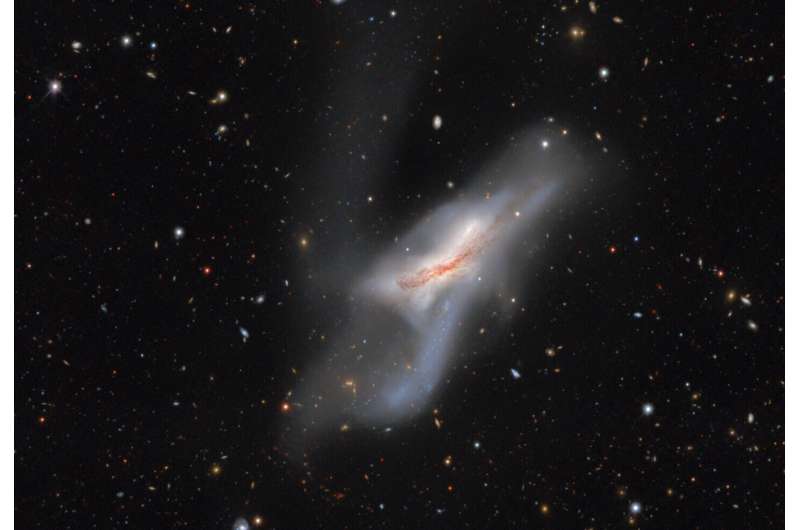
Astronomers have created a detailed atlas of almost 400,000 galaxies in our cosmic neighborhood. The Siena Galaxy Atlas was compiled using data from NSF's NOIRLab telescopes, and is designed to be the preeminent digital galaxy atlas for large galaxies. It's a treasure trove of information for researchers investigating everything from galaxy formation and evolution to dark matter and gravitational waves. It's also freely available online for the public to explore.
This research was presented in a paper that appears in The Astrophysical Journal Supplement Series .
Astronomers have long sought to map the night skies, not only to fill in our picture of the cosmos we inhabit, but also to support further research. Comprehensive compilations of astronomical objects serve many purposes: they can help scientists spot broad patterns across a population of objects, put new discoveries such as transient events in the context of their surroundings, and identify the best candidates for focused observations.
However, these resources must be routinely updated to reflect the continuous technological improvements of telescopes. Now, a new atlas has been released with detailed information on over 380,000 galaxies at a greater level of accuracy than ever before, promising to be a boon to future astronomical inquiry.
The Siena Galaxy Atlas (SGA), is a compilation of data from three surveys completed between 2014 and 2017 known as the DESI Legacy Surveys, which were carried out to identify galaxy targets for the Dark Energy Spectroscopic Instrument (DESI) survey. Data were collected at Cerro Tololo Inter-American Observatory (CTIO) and Kitt Peak National Observatory (KPNO), both Programs of NSF's NOIRLab, and at the University of Arizona's Steward Observatory.
\
The DESI Legacy Surveys used state-of-the-art instruments on telescopes operated by NOIRLab: the Dark Energy Camera Legacy Survey (DECaLS), carried out using the DOE-built Dark Energy Camera (DECam) on the Víctor M. Blanco 4-meter Telescope at CTIO in Chile; the Mayall z-band Legacy Survey (MzLS) with the Mosaic3 camera on the Nicholas U. Mayall 4-meter Telescope at KPNO; and the Beijing-Arizona Sky Survey (BASS) with the 90Prime camera on the Bok 2.3-meter Telescope, which is operated by Steward Observatory and hosted at KPNO.
The DESI Legacy Imaging Surveys data, as well as a queryable copy of the full Siena Galaxy Atlas, are served to the astronomical community via the Astro Data Lab science platform and Astro Data Archive at NOIRLab's Community Science and Data Center (CSDC). The SGA contains additional data from a survey by NASA's Wide-field Infrared Survey Explorer (WISE) satellite that has been reprocessed by Aaron Meisner, an astronomer at NOIRLab
These surveys captured images in optical and infrared wavelengths to chart a total area of 20,000 square degrees—nearly half of the night sky, making it among the largest galaxy surveys. Bringing this wealth of information together in one place, the SGA offers precise data on the locations, shapes and sizes of hundreds of thousands relatively nearby large galaxies. Besides the sheer number of objects recorded, the data in the SGA also achieve a new level of accuracy and it is the first such resource to provide data on the galaxies' light profiles.
"Nearby large galaxies are important because we can study them in more detail than any other galaxies in the universe; they are our cosmic neighbors," notes John Moustakas, professor of physics at Siena College and SGA project leader. "Not only are they strikingly beautiful, but they also hold the key to understanding how galaxies form and evolve, including our very own Milky Way galaxy."
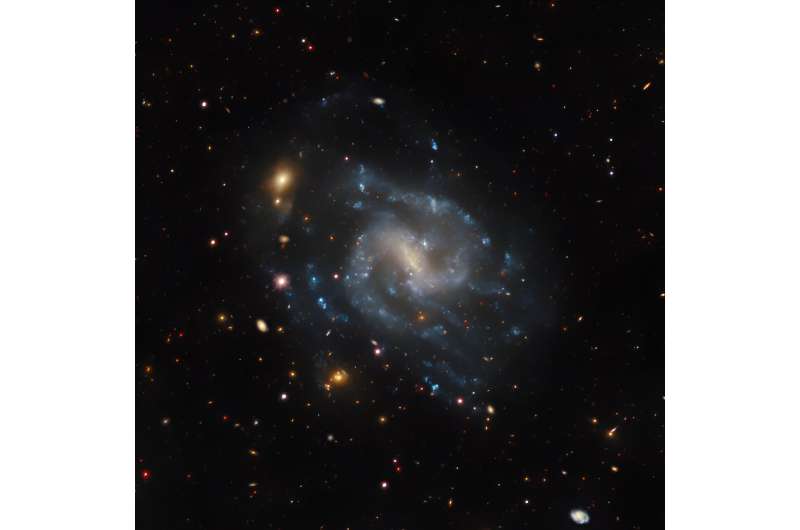
The SGA builds on several centuries of efforts to chart the night skies. The iconic "Catalogue des Nébuleuses et des Amas d'Étoiles (Catalogue of Nebulae and Star Clusters)," published in 1774 by French astronomer Charles Messier, was a major milestone, as was the "New General Catalogue of Nebulae and Clusters of Stars (NGC)," published in 1888 by John Louis Emil Dreyer.
More recently, in 1991, astronomers assembled the "Third Reference Catalog of Bright Galaxies (RC3)." Several other valuable galaxy atlases have been published over the past two decades, but most of them draw on the photographic-plate measurements in the RC3, or are missing significant numbers of galaxies. Since the SGA uses digital images captured with highly sensitive instruments, it represents a substantial improvement in both data quality and completeness.
Arjun Dey, a NOIRLab astronomer who was involved in the project, explains, "Previous galaxy compilations have been plagued by incorrect positions, sizes and shapes of galaxies, and also contained entries which were not galaxies but stars or artifacts. The SGA cleans all this up for a large part of the sky. It also provides the best brightness measurements for galaxies, something we have not reliably had before for a sample of this size."
This versatile resource will drive progress in numerous branches of astronomy and astrophysics by helping scientists find the best galaxy samples for targeted observation. For example, the SGA will enhance research into how patterns of star formation vary across different galaxies, the physical processes underlying the diverse array of morphologies that galaxies display, and how the distribution of galaxies is related to how dark matter is spread across the universe. By acting as a map, the SGA will also help astronomers pinpoint the sources of transient signals like gravitational waves and understand the events that give rise to them.
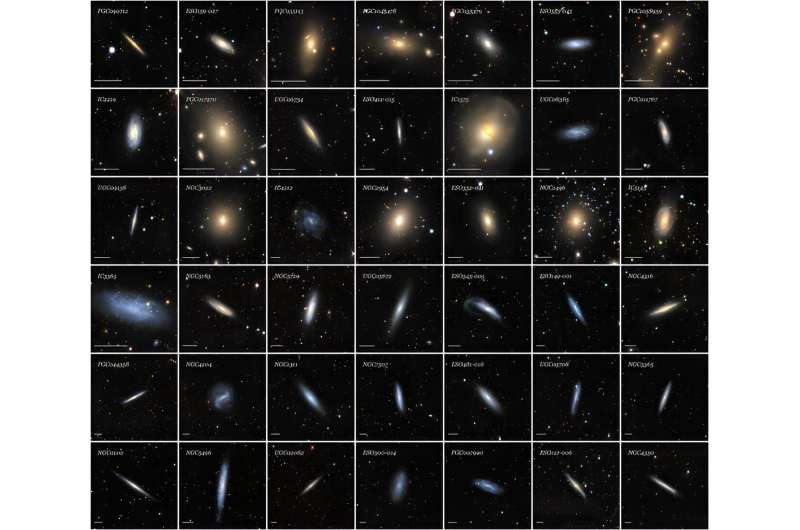
"The SGA is going to be the pre-eminent digital galaxy atlas for large galaxies," says Dey.
However, he points out that the SGA is not just for academic researchers; it is freely available to view online for anyone wishing to get to know our corner of the universe better, adding, "In addition to its scientific utility, it has a lot of pictures of beautiful galaxies."
"The public release of these spectacular data contained in the atlas will have a real impact not only on astronomical research, but also on the public's ability to view and identify relatively nearby galaxies," says Chris Davis, NSF Program Director for NOIRLab. "Dedicated amateur astronomers will particularly love this as a go-to resource for learning more about some of the celestial targets they observe."
More information: John Moustakas et al, Siena Galaxy Atlas 2020, The Astrophysical Journal Supplement Series (2023). DOI: 10.3847/1538-4365/acfaa2
Provided by Lawrence Berkeley National LaboratoryOver one billion galaxies blaze bright in colossal map of the sky
Study suggests gas giants may be more common than thought in some parts of the galaxy
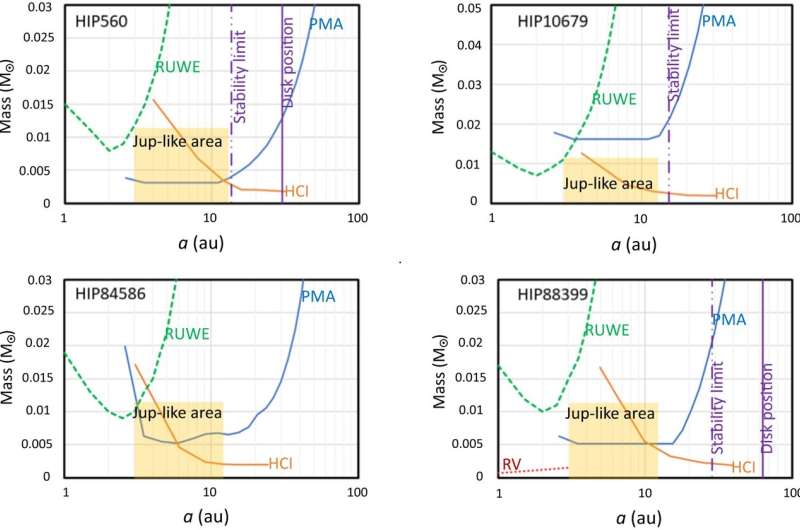
A team of astronomers and astrophysicists from INAF-Osservatorio Astronomico di Padova, Vicolo dell'Osservatorio 5, Universidad Diego Portales, the University of Exeter and Sorbonne Université has found evidence that gas giants may be more common than thought in some parts of the galaxy. In their study, reported in the journal Nature Communications, the group analyzed the mass and movement of 30 stars in the Beta Pictoris Moving Group.
Prior research has suggested that gas giants, similar in some respects to Jupiter, should form easily around stars with properties similar to the sun. But finding them has proven to be difficult, leading some in the planetary community to wonder if these assumptions have been wrong.
For this study, the research team took a new approach—they used a new type of high-contrast imaging to focus on a grouping of stars relatively near to Earth called the Beta Pictoris Moving Group. Prior research has shown that the small cluster of stars move together through space.
In their work, the research team focused on 30 stars in the group, seeking to determine their mass and movements. The team chose the group for several reasons: It is relatively small, there is a lot of space between the stars, and they seem to be rather young. They reasoned that gas giants might be more likely to develop in such places. The team found evidence of the potential existence of gas giants in 20 of the star systems they studied—all of which, if they do exist, orbit far from their star.
More work is required to confirm their findings. The researchers also suggest that gas giants appear more likely to form in small, low population groups, which have not typically been the focus of intense research efforts. And that, they point out, suggests that there may be many more gas giants than previously thought.
More information: Raffaele Gratton et al, Jupiter-like planets might be common in a low-density environment, Nature Communications (2023). DOI: 10.1038/s41467-023-41665-0
India plans manned Moon mission, space station

India plans to send a man to the moon and set up a space station by 2040, Prime Minister Narendra Modi said, as the country ramps up its space program.
The premier's announcement comes as the world's most populous country readies for a key test flight due Saturday for its first crewed space mission.
Modi told space agency officials that they should "build on the success of Indian space initiatives".
The country "should now aim for new and ambitious goals, including setting up 'Bharatiya Antariksha Station' (Indian Space Station) by 2035 and sending first Indian to moon by 2040," he said in a statement late Tuesday.
Modi asked them to develop plans for "a series of missions" to the moon.
India runs a low-budget space operation. It became the first to land a craft near the largely unexplored lunar south pole in August and, a month later, successfully launched a spacecraft to observe the outermost layers of the sun.
In 2014, India became the first Asian nation to put a satellite into orbit around Mars, and its space agency Indian Space Research Organisation (ISRO) launched 104 satellites in a single mission in 2017.
India's current focus remains on its first manned mission into outer space, called Gaganyaan or "Skycraft".
The three-day mission, expected to take place next year, aims to send a three-member crew into Earth's orbit at a cost of about $1.08 billion, according to ISRO.
The country also plans to launch a probe to the moon with Japan, land a craft on Mars, and send an orbital mission to Venus within the next two years.
India has been steadily matching the achievements of established spacefaring powers at a fraction of their cost.
Experts say India can keep costs low by copying and adapting existing technology, and thanks to an abundance of highly skilled engineers who earn a fraction of their global counterparts.
India says it only accounts for two percent of the $386 billion global space economy, a share it hopes to increase to nine percent by 2030.
© 2023 AFP
India space chief unfazed by Moon mission's apparent end
Searching for concentrated biosignatures in an ancient Mars mud lake
by Planetary Science Institute
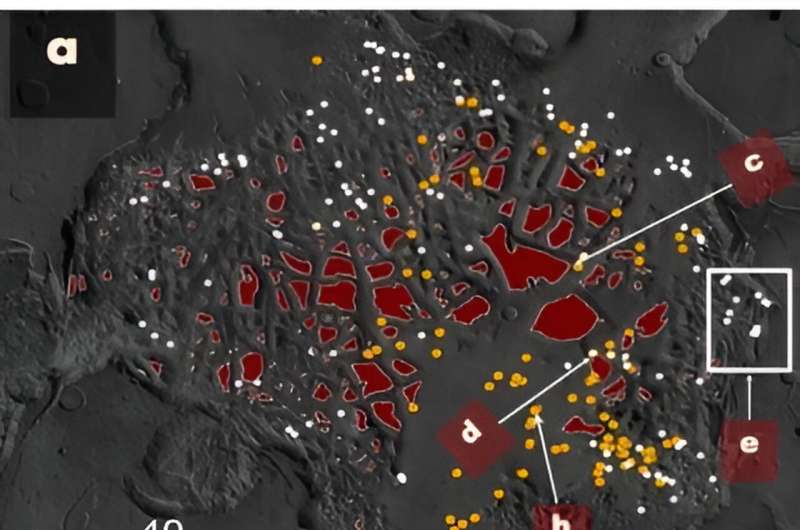
A landmark discovery by a collaborative team led by the Planetary Science Institute's Alexis Rodriguez has unveiled evidence of sedimentary plains created by aquifer drainage within Martian collapse formations termed chaotic terrains.
"Our research focuses on a sedimentary unit within Hydraotes Chaos, which we interpret to be the remnants of a mud lake formed by discharges from gas-charged mudstone stratigraphy dating back to nearly 4 billion years ago, a time when the surface of Mars was likely habitable," said Rodriguez, lead author of the paper, "Exploring the evidence of middle Amazonian aquifer sedimentary outburst residues in a Martian chaotic terrain," published in Scientific Reports.
"These sediments might harbor evidence of life from that or subsequent periods. It is important to remember that the subsurface of Mars might have included habitability lasting the duration of life's history on Earth."
PSI scientists Bryan Travis, Jeffrey S. Kargel and Daniel C. Berman are co-authors on the paper. Scientists from NASA Ames Research Center, the University of Arizona, Autonomous University of Barcelona, Blue Marble Space Institute of Science, and the University of Florida are also co-authors on the project.
The extensive study of Martian aquifer drainage has revealed enormous flood channels that stretch thousands of kilometers into the planet's northern lowlands. The prodigious erosion caused by these channels, combined with the subsurface sediments released from the aquifers, blankets extensive portions of the northern lowlands. This complex landscape presents a formidable challenge for the investigation of the nature of the Martian aquifers.
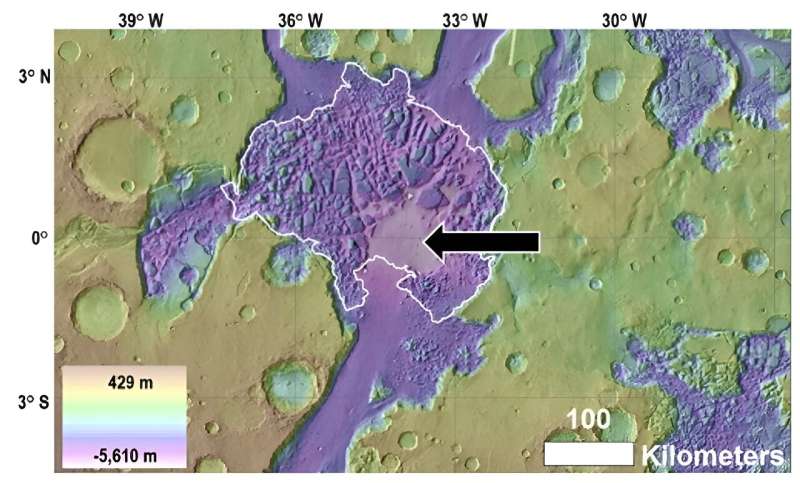
"Venturing into the northern plains for sampling could prove precarious, as distinguishing between materials sourced from the aquifers and those eroded and transported during channel formation could become an intricate task. The plains, situated within Hydraotes Chaos, offer a unique glimpse into ancient aquifer materials. These plains, which we think formed from mud extruding into a basin directly above their source aquifer, provide a more targeted exploration opportunity," Rodriguez said.
"Unlike vast flood channels with their complex erosion patterns, this finding simplifies the examination of Martian aquifers, reducing the risk of overland sedimentary acquisition, and opens a new window into Mars' geological past."
"Our numerical models reveal a fascinating story. The lake's source aquifer likely originated from phase segregation within the mudstone, forming vast water-filled chambers, several kilometers wide and hundreds of meters deep. This process was likely triggered by intrusive igneous activity," co-author Travis said.
"Moreover, the observed segmented subsidence across the chaotic terrain suggests an interconnected network of chambers, depicting stable water-filled giant caverns, some reaching kilometers in widths and lengths, way larger than any known Earth counterparts."
"Initially biomolecules could have been dispersed throughout the volume of large groundwater filled cavities. As the water was released to the surface and ponded, the water went away leaving behind lags of sediments and potentially high concentrations of biomolecules," Rodriguez said.
Therefore, the residue of this ancient mud lake could provide unprecedented access to aquifer materials enriched in biomolecules that have remained hidden within Mars' subsurface for most of its existence.
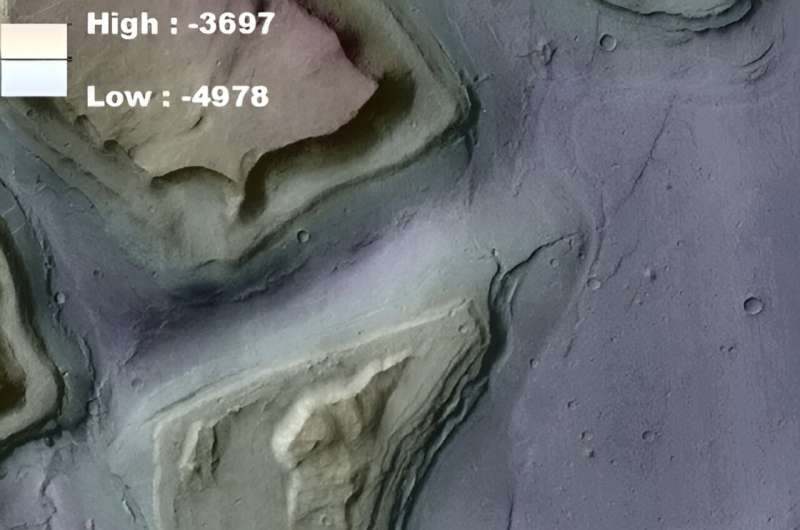
"NASA Ames is considering the plains as a possible landing site for a mission to search for evidence of biomarkers, specifically lipids. These biomolecules are extremely resistant and could have endured billions of years on Mars," co-author Mary Beth Wilhelm of NASA Ames Research Center said.
"In addition, the study region includes widespread mud volcanoes and possible diapirs, providing additional windows into subsurface, potentially habitable rocks. A small rover could within short distances sample the mud lake sediments and these materials, dramatically increasing the odds of biosignature detection," co-author Kargel said.
"Our crater counts indicate that the plains are relatively recent, returning an age of 1 billion years. This age is good news for our search for life. This age is way younger than the ages of most aquifer releases on Mars, dating back to approximately 3.4 billion years ago. So, the materials spent a huge amount of time in the subsurface," co-author Berman said.
More information: Rodriguez, J.A.P et al, Exploring the evidence of Middle Amazonian aquifer sedimentary outburst residues in a Martian chaotic terrain, Scientific Reports (2023). DOI: 10.1038/s41598-023-39060-2
Journal information: Scientific Reports
Provided by Planetary Science Institute
SpaceX launch equals Space Coast record for the year
by Richard Tribou, Orlando Sentinel

A SpaceX launch from Cape Canaveral Space Force Station on Tuesday night marked the Space Coast's 57th launch of the year, equaling the record total seen in 2022.
A Falcon 9 with 22 of SpaceX's Starlink internet satellites lifted off from Canaveral's Space Launch Complex 40 at 8:36 p.m. This was the first-stage booster's 16th flight with a recovery landing downrange on the droneship Just Read the Instructions in the Atlantic.
For SpaceX it was its 53rd mission from either Canaveral or Kennedy Space Center this year while United Launch Alliance has flown three times and Relativity Space has flown once. SpaceX is the lone launch provider this year from KSC having flown 11 times while ULA, SpaceX and Relativity combined for 46 launches from Canaveral.
The majority of SpaceX launches have been for its growing Starlink constellation. This marks the 31st Starlink launch from the Space Coast.
But SpaceX has also flown all three U.S.-based crewed missions this year with Crew-6, Axiom 2 and Crew-7 all having launched from KSC. KSC has also hosted four of the Falcon Heavy launches including last week's Psyche launch, the first time NASA has used the powerhouse rocket.
The pace between launches has picked up as well, with only an eight hour and 42 minute gap between the Psyche launch that happened Friday morning and a Starlink launch on Friday evening.
That's the shortest time between launches since four Gemini program missions that flew in 1966. Those featured double launches from two different pads on what was then Cape Kennedy.
Those would send crew up in the Gemini capsule on Titan rockets about 100 minutes after Atlas boosers had sent up Agena Target Vehicles with which they would rendezvous in space. The record remains the two launches with Gemini 11, which sent up Pete Conrad and Richard Gordon from Launch Complex 19 only 97 minutes and 25 seconds after the Agena launch from Launch Complex 14 just over 1 mile to the south.
SpaceX itself has kept setting turnaround records for launches from SLC 40 at one point sending up two launches from the pad in under four days.
With about 11 weeks to go, the Eastern Range could end up with more than 70 launches for the year if it maintains its pace.
SpaceX has several more Starlink flights planned as well as the CRS-29 resupply mission as early as Nov. 1 and what could be the first successful launch of NASA's Commercial Lunar Payload Services (CLPS) missions on Nov. 14, which aims to send the Intuitive Machines IM-1 lunar lander on its way to the moon.
There could also be one more Falcon Heavy launch before the end of the year on the USSF-52 mission for the Space Force.
While Relativity Space was one and done with its lone launch of the 3D-printed Terran 1 rocket in March, ULA could squeeze in one more flight before the year's end with the first launch of its new Vulcan Centaur rocket. The much-delayed flight of the replacement for ULA's Atlas and Delta family of rockets could fly in December, according to ULA President and CEO Tory Bruno. It had been targeting a May liftoff this year, and was on tap to make its primary payload, Astrobotic's Peregrine lunar lander, the first CLPS moon mission.
Space Launch Delta 45 leadership said at the beginning of the year, the Space Coast could have seen up to 92 launches in 2023, and a pace of two launches per week is something expected in the coming years as more rocket companies get their hardware to the launch pads.
SpaceX's pace is not expected to slow while ULA aims to ramp up its Vulcan Centaur flights to at least twice a month. Meanwhile, Jeff Bezos' Blue Origin hopes to bring its New Glenn heavy lift rocket into space for the first time before the end of 2024., although that might slip to 2025.
2023 Orlando Sentinel. Distributed by Tribune Content Agency, LLC.
SpaceX launch today would equal Space Coast record for the year
No comments:
Post a Comment